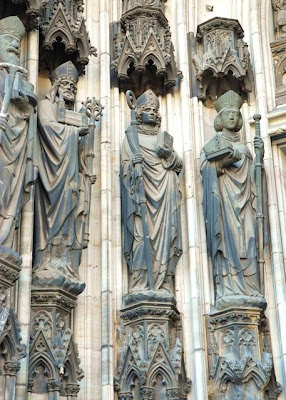.JPG)
.JPG) We landed at 8:30 am on Saturday May 10th - my aunt Sasha's birthday. The airport appeared to be empty - we were the only flight at the baggage claim.
We landed at 8:30 am on Saturday May 10th - my aunt Sasha's birthday. The airport appeared to be empty - we were the only flight at the baggage claim. 
That same Saturday after 32 hours of travel time and only 2 hours of sleep on the plane from New York to Cologne, we went to see the Dom and visit the huge square right in front of it. It was very busy with lots of people, lots of protests and people dressed like this:



There were quite a few artists that were working on the ground, creating these beautiful images. All images get destroyed by the end of the day and then it starts all over again:
We spent all afternoon in the old core of the town, called Altstadt, which is undoubtelly the most charming part of the town. It is situated along the bank of the river Rhein and in the close vicinity of the Dom. The Altstadt is characteristic for its network of short and narrow streets, but most of all, for the traditional houses congested one to another and each coloured in different vivid colours. This part of the town is full of fine breweries, restaurants and nice looking shops..jpg)
We were passed many times by the beer bike. It spaced about 10 people all drinking beer while peddling their bike around.
Cologne Cathedral, or Kölner Dom in German is officially called Hohe Domkirche St. Peter und Maria. It is the seat of Archbishop of Cologne under the administration of the Roman Catholic Church and is a renowned monument of Christianity and of Gothic Architecture.




Treasures of Cologne Cathedral
The most celebrated work of art in the cathedral is the Shrine of the Three Kings, a large gilded sarcophagus dating from the 13th century, and the largest reliquary in the Western world. It is traditionally believed to hold the remains of the Three Wise Men, whose bones and 2,000-year-old clothes were discovered at the opening of the shrine in 1864.







.JPG)







.JPG)

No comments:
Post a Comment